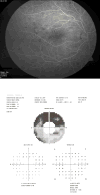A proposal for early and personalized treatment of diabetic retinopathy based on clinical pathophysiology and molecular phenotyping
- PMID: 28438679
- PMCID: PMC5987228
- DOI: 10.1016/j.visres.2017.03.006
A proposal for early and personalized treatment of diabetic retinopathy based on clinical pathophysiology and molecular phenotyping
Abstract
This paper presents a new approach to the prevention and treatment of early stage diabetic retinopathy before vision is severely impaired. This approach includes two major steps. The first step is to understand the mechanisms of vision impairment and classify diabetic retinopathy on the basis of pathophysiologic adaptations, rather than on the presence of advanced pathologic lesions, as defined by current clinical practice conventions. The second step is to develop patient-specific molecular diagnoses of diabetic retinopathy so that patients can be treated based on their individual characteristics, a process analogous to the individualized diagnosis and treatment of cancer patients. This step is illustrated by proteomic analysis of vitreous fluid that reveals evidence of neuroretinal degeneration and inflammation, as well as vascular proliferation. Together, these steps may lead to improved means to preserve vision in the ever-increasing number of patients with diabetes worldwide.
Keywords: Diabetic retinopathy; Molecular diagnosis; Neurovascular unit; Retinal failure; Vitreous proteomics.
Copyright © 2017 Elsevier Ltd. All rights reserved.
Figures





Similar articles
-
The neurovascular unit and the pathophysiologic basis of diabetic retinopathy.Graefes Arch Clin Exp Ophthalmol. 2017 Jan;255(1):1-6. doi: 10.1007/s00417-016-3548-y. Epub 2016 Nov 10. Graefes Arch Clin Exp Ophthalmol. 2017. PMID: 27832340 Free PMC article. Review.
-
Diabetic retinopathy: pathogenesis, clinical grading, management and future developments.Diabet Med. 2013 Jun;30(6):640-50. doi: 10.1111/dme.12089. Diabet Med. 2013. PMID: 23205608 Review.
-
Diabetic retinopathy: Proteomic approaches to help the differential diagnosis and to understand the underlying molecular mechanisms.J Proteomics. 2017 Jan 6;150:351-358. doi: 10.1016/j.jprot.2016.06.034. Epub 2016 Jul 1. J Proteomics. 2017. PMID: 27373871 Review.
-
Management of proliferative diabetic retinopathy.Compr Ophthalmol Update. 2007 Sep-Oct;8(5):245-56. Compr Ophthalmol Update. 2007. PMID: 18201511 Review.
-
New insights into the pathophysiology of diabetic retinopathy: potential cell-specific therapeutic targets.Diabetes Technol Ther. 2000 Winter;2(4):601-8. doi: 10.1089/15209150050502023. Diabetes Technol Ther. 2000. PMID: 11469624 Review.
Cited by
-
Proteomic Biomarkers of Retinal Inflammation in Diabetic Retinopathy.Int J Mol Sci. 2019 Sep 25;20(19):4755. doi: 10.3390/ijms20194755. Int J Mol Sci. 2019. PMID: 31557880 Free PMC article. Review.
-
Comparative proteomics of proliferative diabetic retinopathy in people with Type 2 diabetes highlights the role of inflammation, visual transduction, and extracellular matrix pathways.Indian J Ophthalmol. 2023 Aug;71(8):3069-3079. doi: 10.4103/IJO.IJO_276_23. Indian J Ophthalmol. 2023. PMID: 37530283 Free PMC article.
-
Current understanding of the molecular and cellular pathology of diabetic retinopathy.Nat Rev Endocrinol. 2021 Apr;17(4):195-206. doi: 10.1038/s41574-020-00451-4. Epub 2021 Jan 19. Nat Rev Endocrinol. 2021. PMID: 33469209 Free PMC article. Review.
-
Quantitative Assessment of Choroidal Parameters in Patients with Various Types of Diabetic Macular Oedema: A Single-Centre Cross-Sectional Analysis.Biology (Basel). 2021 Jul 29;10(8):725. doi: 10.3390/biology10080725. Biology (Basel). 2021. PMID: 34439957 Free PMC article.
-
Vitreous Humor Proteome: Targeting Oxidative Stress, Inflammation, and Neurodegeneration in Vitreoretinal Diseases.Antioxidants (Basel). 2022 Mar 6;11(3):505. doi: 10.3390/antiox11030505. Antioxidants (Basel). 2022. PMID: 35326156 Free PMC article. Review.
References
-
- Goldberg MF, Fine SL. Symposium on the treatment of diabetic retinopathy. Washington, DC: US Govt Printing Office; 1969.
-
- Diabetic retinopathy study. Report Number 6. Design, methods, and baseline results. Report Number 7. A modification of the Airlie House classification of diabetic retinopathy. Prepared by the Diabetic Retinopathy. Investigative ophthalmology & visual science. 1981;21(1 Pt 2):1–226. - PubMed
-
- Anonymous. Grading diabetic retinopathy from stereoscopic color fundus photographs–an extension of the modified Airlie House classification. ETDRS report number 10. Early Treatment Diabetic Retinopathy Study Research Group. Ophthalmology. 1991;98(5 Suppl):786–806. - PubMed
Publication types
MeSH terms
Grants and funding
LinkOut - more resources
Full Text Sources
Other Literature Sources
Medical

